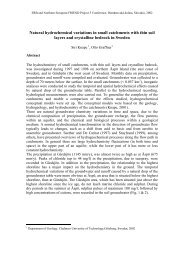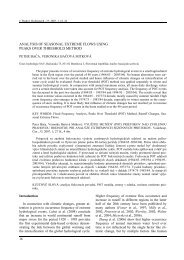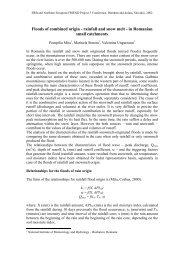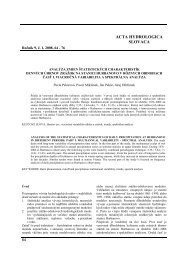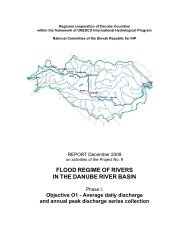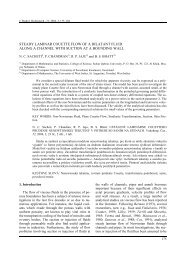LOCAL HEAD LOSS IN PLASTIC PIPELINE JOINT WELDED BY ...
LOCAL HEAD LOSS IN PLASTIC PIPELINE JOINT WELDED BY ...
LOCAL HEAD LOSS IN PLASTIC PIPELINE JOINT WELDED BY ...
Create successful ePaper yourself
Turn your PDF publications into a flip-book with our unique Google optimized e-Paper software.
J. Melichar, J. Háková, J. Veselský, L. Michlík<br />
Fig. 3. Test section of the test loop, location of pressure taps and pressure-difference sensors; S – pipe jointing point, 1, 2, 3 – pressure<br />
taps.<br />
Obr. 3. Experimentální úsek potrubní trasy, umístění odběrů tlaků a snímačů tlakové diference; S – spoj potrubí, 1, 2, 3 – odběry<br />
statického tlaku.<br />
The horizontal test section of the test loop is<br />
composed of the proper metering pipe length (pipeline<br />
joint between pressure taps 2 and 3) with sufficient<br />
straight pipeline length before (l2S ≈ 5.1d) and<br />
behind the jointing point (lS3 ≈ 10.13d), where the<br />
influence of jointing point on flow pattern is anticipated.<br />
In front of this measuring section there is a<br />
straight pipeline with the corresponding length (l12<br />
= l2S + lS3 = l23 – b = 15.23d). The inner projection<br />
of the butt weld with length b ≈ 0.08d in the pipeline<br />
joint affects the flow in particular behind the<br />
jointing point, where the head loss occurs at relatively<br />
long pipeline length. The losses in a pipeline<br />
before and behind the butt weld or more precisely<br />
the lengths, which we can assume to have significant<br />
influence on flow pattern, depend on the type<br />
of element, its geometric parameters, pipeline wall<br />
roughness and the Reynolds number value. Skalička<br />
(1985) showed that the flow pattern could be sometimes<br />
affected on the distance of 50d behind the<br />
element projection that evokes the head loss. However,<br />
for location of static pressure taps in relation<br />
to measured element there are no any universal<br />
recommendations. With reference to the butt weld<br />
302<br />
geometry and used pipeline material (βPP-H is nontransparent)<br />
the above-mentioned distances between<br />
static pressure taps and examined jointing<br />
point were used. Static pressure taps at a pipeline<br />
cross-section (metering locations) in the experimental<br />
pipeline were made of four pipeline side inlets<br />
that were evenly placed. Fig. 4 shows the detailed<br />
arrangement.<br />
The static pressure differences, ∆p12, between the<br />
cross-section 1 and 2 and ∆p23 between the crosssection<br />
2 and 3 were measured with the use of calibrated<br />
differential pressure sensors with range 0 –<br />
–16 kPa/4 – 20 mA. The estimated accuracy of<br />
pressure difference measurements is up to 0.25 % of<br />
a measuring range. The flow rate, Q, was measured<br />
using magnetic flow meter of type MQI 99<br />
SMART. The accuracy 0.5 % of measured flow rate<br />
was guaranteed within the range of 10 to 100 %<br />
of Qmax. The mercury thermometer was used to<br />
measure the water temperature. The analogue output<br />
signals from the magnetic flow meter and the<br />
differential manometers were compiled by A/D<br />
converter UDAQ – 1208 and transmitted and stored<br />
into PC using program for UDAQ – 1208 proces-




